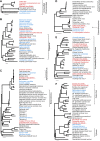Twenty-Five New Viruses Associated with the Drosophilidae (Diptera)
- PMID: 27375356
- PMCID: PMC4915790
- DOI: 10.4137/EBO.S39454
Twenty-Five New Viruses Associated with the Drosophilidae (Diptera)
Abstract
Drosophila melanogaster is an important laboratory model for studies of antiviral immunity in invertebrates, and Drosophila species provide a valuable system to study virus host range and host switching. Here, we use metagenomic RNA sequencing of about 1600 adult flies to discover 25 new RNA viruses associated with six different drosophilid hosts in the wild. We also provide a comprehensive listing of viruses previously reported from the Drosophilidae. The new viruses include Iflaviruses, Rhabdoviruses, Nodaviruses, and Reoviruses, and members of unclassified lineages distantly related to Negeviruses, Sobemoviruses, Poleroviruses, Flaviviridae, and Tombusviridae. Among these are close relatives of Drosophila X virus and Flock House virus, which we find in association with wild Drosophila immigrans. These two viruses are widely used in experimental studies but have not been previously reported to naturally infect Drosophila. Although we detect no new DNA viruses, in D. immigrans and Drosophila obscura, we identify sequences very closely related to Armadillidium vulgare iridescent virus (Invertebrate iridescent virus 31), bringing the total number of DNA viruses found in the Drosophilidae to three.
Keywords: Drosophila; Drosophila X virus; Flock House virus; metagenomics; transcriptome; virus.
Figures



Similar articles
-
The Discovery, Distribution, and Evolution of Viruses Associated with Drosophila melanogaster.PLoS Biol. 2015 Jul 14;13(7):e1002210. doi: 10.1371/journal.pbio.1002210. eCollection 2015 Jul. PLoS Biol. 2015. PMID: 26172158 Free PMC article.
-
Naturally occurring viruses of Drosophila reduce offspring number and lifespan.Proc Biol Sci. 2024 May;291(2023):20240518. doi: 10.1098/rspb.2024.0518. Epub 2024 May 15. Proc Biol Sci. 2024. PMID: 38747703 Free PMC article.
-
The discovery, distribution, and diversity of DNA viruses associated with Drosophila melanogaster in Europe.Virus Evol. 2021 Apr 1;7(1):veab031. doi: 10.1093/ve/veab031. eCollection 2021 Jan. Virus Evol. 2021. PMID: 34408913 Free PMC article.
-
Insect antiviral innate immunity: pathways, effectors, and connections.J Mol Biol. 2013 Dec 13;425(24):4921-36. doi: 10.1016/j.jmb.2013.10.006. Epub 2013 Oct 9. J Mol Biol. 2013. PMID: 24120681 Free PMC article. Review.
-
Drosophila viruses and the study of antiviral host-defense.Adv Virus Res. 2008;72:227-65. doi: 10.1016/S0065-3527(08)00406-5. Adv Virus Res. 2008. PMID: 19081493 Review.
Cited by
-
Viromics Reveal a Number of Novel RNA Viruses in Swedish Mosquitoes.Viruses. 2019 Nov 5;11(11):1027. doi: 10.3390/v11111027. Viruses. 2019. PMID: 31694175 Free PMC article.
-
The Viromes of Mosquitoes from the Natural Landscapes of Western Siberia.Viruses. 2023 Sep 8;15(9):1896. doi: 10.3390/v15091896. Viruses. 2023. PMID: 37766302 Free PMC article.
-
Ythdf is a N6-methyladenosine reader that modulates Fmr1 target mRNA selection and restricts axonal growth in Drosophila.EMBO J. 2021 Feb 15;40(4):e104975. doi: 10.15252/embj.2020104975. Epub 2021 Jan 11. EMBO J. 2021. PMID: 33428246 Free PMC article.
-
Wolbachia Offers Protection Against Two Common Natural Viruses of Drosophila.Microb Ecol. 2025 Apr 9;88(1):24. doi: 10.1007/s00248-025-02518-z. Microb Ecol. 2025. PMID: 40202691 Free PMC article.
-
Diversity of Picorna-Like Viruses in the Teltow Canal, Berlin, Germany.Viruses. 2024 Jun 25;16(7):1020. doi: 10.3390/v16071020. Viruses. 2024. PMID: 39066183 Free PMC article.
References
-
- Huszart T, Imler JL. Drosophila viruses and the study of antiviral host-defense. Adv Virus Res. 2008;72:227–65. - PubMed
-
- Bronkhorst AW, van Rij RP. The long and short of antiviral defense: small RNA-based immunity in insects. Curr Opin Virol. 2014;7(0):19–28. - PubMed
-
- Chtarbanova S, Imler JL. Innate antiviral immunity in Drosophila. Virologie. 2011;15(5):296–306. - PubMed
-
- Dostert C, Jouanguy E, Irving P, et al. The Jak-STAT signaling pathway is required but not sufficient for the antiviral response of Drosophila. Nat Immunol. 2005;6(9):946–53. - PubMed
Grants and funding
LinkOut - more resources
Full Text Sources
Other Literature Sources
Molecular Biology Databases

